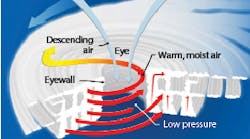Part 1 discussed whether global warming is significant, and whether it's caused by CO2.
Part 2 discussed the effects from melting ice, rising oceans and the "heat engine."
Because the Earth is spinning, the velocity of a point on its surface increases with its diameter. At the poles it is near zero; at the equator, close to 2,000 mph, and in the United States, it’s around 1,000 mph. If the Earth did not spin, we would have 300 mph winds between the poles and the tropics (and back again) as the colder, denser and therefore higher-pressure air at the poles would move on the surface of the globe in straight lines toward the low-pressure regions near the equator and back in the upper atmosphere. This would occur, as the air density is lower near the equator due to its higher temperature and moisture content.
But the Earth is rotating from west to east, and because its surface velocity drops as we move toward the poles, both the winds and the ocean currents tend to move in the opposite direction (east to west) and "downhill" toward the poles. This downhill effect is called the Coriolis effect, which you can visualize by thinking of two athletes running at equal speeds, on two concentric circular paths where the diameter of #1 is larger than #2.
Now think of a ball that the athlete running on the larger-diameter #1 path throws directly to he athlete on the smaller-diameter #2 path. What happens? The ball does not arrive at athlete #2, but in front of him. Similarly, if athlete #2 throws the ball, it arrives behind #1.
Now if you mentally substitute for the ball, the water or air on the surface of the Earth, you will see that the Coriolis force is moving them down toward the poles. Therefore, they will move clockwise in the northern hemisphere and counterclockwise in the southern hemisphere.
Over warm ocean areas, heated air expands and rises, creating vacuum below. This vacuum causes more evaporation and pulls in colder air. At the same time, the Coriolis force rotates the hurricane clockwise in the northern hemisphere and counterclockwise in the southern.
Winds and precipitation
Let us first look at the characteristics of the behavior of the atmosphere with the eye of a process control engineer. One of the processes taking place is the movement of water vapors from the tropics toward the poles. We call this the water cycle, as in the higher-temperature regions, the water continuously evaporates and the resulting water vapor continuously enters the atmosphere, and this high-humidity air travels from east to west and toward the cooler regions, where some of the water vapor condenses and produces precipitation (rain or snow), while the dryer and cooler air returns. This water cycle is the pump that moves the water from the tropics toward the poles, resulting in an average annual precipitation on the entire surface of the planet of about 1,050 millimeters (one meter) per year.
Now let us see what happens to this "pumping loop process" when the concentration of heat-absorbing greenhouse gases increases in the atmosphere and therefore the air warms. Well, the warmer air can hold more moisture. It is for this reason that during the past four decades, the average moisture content of the atmosphere increased from about 4 parts per million by volume (ppmv) to about 5 ppmv. In terms of the mass of water in the air, it means that during the past century, the weight of a column of water vapor over a square meter of the Earth's surface increased by about 0.41 kg/m², and it’s rising by about 7% per °C temperature rise. The increased rate of evaporation increases the flowrate in the water cycle, which causes water shortages in the tropics and increases the rate of condensation (rain and snowfall) in the temperate zones.
Hurricanes
When the air is heated at hot spots of the ocean's surface, convection (movement of the heat) occurs because as the heated air expands (becomes less dense than the surrounding air), it rises and transports the heat upwards, while creating vacuum below. This vacuum causes more evaporation, while it also pulls in colder air (Figure 1). At the same time, the Coriolis force rotates the hurricane clockwise in the northern hemisphere and counterclockwise in the southern.
As the ocean temperatures rise due to global warming, both the frequency and the power of the hurricanes (called typhoons or tropical cyclones on the southern hemisphere) increases. On the northern hemisphere, hurricanes are moved by westerly winds, and when they reach land and collide with the colder air masses, they can cause extremely heavy rains and damaging thunderstorms or tornados.
Ocean currents move to the west in the northern and east in the southern hemisphere. Land masses and the Coriolis effect cause the movements to become more or less circular, forming the gyres.
Ocean currents
The temperature difference between the tropics and the polar regions also drives the ocean's "heat conveyor," which moves the heat to the north in the northern hemisphere. Both the ocean currents and the winds support this process as the transported heat warms the temperate zones. The ocean currents move clockwise in the northern and counterclockwise in the southern hemisphere. If there were no land masses to interrupt this movement, the ocean currents would move to the west in the northern and to the east in the southern hemisphere. However, because of the land masses and the Coriolis effect, the movement of these currents becomes more or less circular. They are called gyres (Figure 2).
As the ocean's upper 400-m layer (about 10% of ocean's total mass) moves toward the poles, it absorbs heat near the equator and releases it further to the north. Thereby, it heats the American East Coast and Europe, resulting in milder climates there. In addition, as discussed earlier, as the oceans absorb more heat near the Equator, more evaporation occurs there, and therefore, the winds bring more rain in the summer and more snow in the winter to these regions.
Some believe that the ocean currents that move the heat from the tropics toward the poles are slowing.
In the northern hemisphere, the upper 400-m layers of the oceans move toward Greenland, where that current cools and sinks. This sinking water displaces the lower layers of the ocean and causes the formation of currents that move the ocean's lower layers back toward the Equator. In the past, the sinking of the upper layer occurred because as the water cooled, its density increased and this heavier water displaced the water below.
Some believe that this circulation rate is slowing because the density of the ocean's upper layer is dropping. This occurs because lighter fresh water from melting ice in Greenland is mixing with the heavier salt water, reducing the density of their mixture. If that is the case, the heat conveyor of the gulf current is bringing less heat toward the pole. If this slowing is in fact occurring, then the tropical zones should be getting warmer, while the temperate zones should be cooling. This slowing of the gulf current could be occurring today, and if it is, it could reduce the effects of global warming on the East Coast of the United States. (Figure 3).
In the first three parts of this series, I applied the principles of process control engineering to analyze the causes and effects of climate change and the dynamic properties of these processes. Since it is clear that the cause of climate change is not only the increased energy consumption of mankind, but also the types of energy sources used, next time I’ll discuss energy sources that do not affect the climate.









